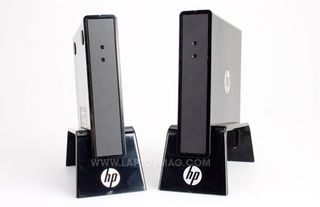Laptop Mag Verdict
This accessory lets you wirelessly beam 1080p video and games from your laptop to your TV with zero lag.
Pros
- +
Easy setup
- +
Plays any HD content
- +
No latency
Cons
- -
Expensive
- -
Bulky transmitter
Why you can trust Laptop Mag
There are a number of technologies for wirelessly outputting your notebook's display to a larger TV, including Intel's WiDi. But WiDi doesn't yet handle copy-protected content, such as Blu-ray movies. And the technology still suffers from latency, which means no gaming. Enter HP's Wireless TV Connect. This accessory uses a competing technology, called wireless HDMI, to stream anything from your laptop to your big screen without the lag. Is that power and added versatility worth $199?
Design
The Wireless TV Connect consists of two boxes--a transmitter and receiver--one of which hooks up to your notebook, and the other to a TV or projector. Unlike the ASUS WiCast EW2000, which has a smaller transmitter, both boxes are the same size (4.5 x 4.1 x 1) and are made of a glossy black plastic. It's a lot more cumbersome than the Warpia StreamHD, which only requires a small USB dongle.
The transmitter has an HDMI port and USB port, while the receiver has HDMI, USB, and a power port. The front of each box has two LEDs: a white one indicates it's on, and a blue light indicates it's connected. Both also have small reset buttons.
Setup
Setting up the HP Wireless TV Connect was easy. Step 1: Plug the transmitter into a PC's HDMI and USB ports. Step 2: Plug the receiver into the TV via HDMI, and the wall plug into the power port. Not only does HP provide all the necessary cables, it even color-codes them. Within a few seconds, the two devices recognized each other. After we opened the Windows Display control panel and changed the settings, our laptop's display was mirrored on our TV. Unlike with the Warpia StreamHD (which uses wireless USB), there's no need to install software of any kind.
Because the Wireless TV Connect essentially acts as a long HDMI cable, we had no problem playing protected content, as we have with Intel's Wireless Display technology. (WiDi 2.0 will support DRM content with an upgrade later this spring.)
Of course, like the WiCast, using the Wireless TV Connect means that your HDMI and one of your USB ports is occupied, and the transmitter itself is kind of clunky. Moreover, there's no way to attach it to your notebook's lid. While the same is true for the WiCast, at least ASUS includes little Velcro tabs for you to use. However, both ASUS' transmitter and receiver have fans in them to keep them cool; you can hear them in a quiet room. While HP's device is larger, it has a fanless design.

Click to enlarge
Performance
The HP Wireless TV Connect uses WHDI (Wireless Home Digital Interface) technology, which lets you beam signals with less than a 1-milisecond delay, and has a data rate of about 3GBps. Not surprisingly, HP's device worked just as well as ASUS' (which uses the same technology): Using an older Sony VAIO Z with a Core 2 Duo processor and Nvidia GeForce 9300M G graphics, we streamed a 1080p video of Kingdom of Heaven from our notebook's hard drive to a 46-inch Samsung HDTV from across our living room, about 10 feet away. (The device is rated for up to 100 feet).
When using the TV as the only display, action was smooth and seamless, but when we used our notebook with the Samsung TV in extended mode, there was some banding and audio and video was slightly out of sync at times, especially during action sequences; we didn't encounter this problem with the WiCast, though. However, when we used the Wireless TV Connect with a more modern Alienware notebook, the problem went away.
Regardless, there was no lag whatsoever when moving windows with video running, or playing games such as Call of Duty: Modern Warfare 2, and performance was on a par with the Asus WiCast. By comparison, the Warpia StreamHD had much more trouble playing high-def content; when a video was running, the cursor would jump around the screen.
There's one byproduct of DRM: If your notebook's display and your TV are cloned, you can only watch a Blu-ray on one of the screens. We encountered the same issue with the WiCast, too. However, this isn't a problem if you use extended mode, or use the TV as your primary display.
Verdict
While wireless streaming is still in its infancy, the HP Wireless TV Connect offers very good performance. Yes, the $199 price is steep and the device is bulky compared to the $159 Warpia Stream HD, but HP's device provides a much better overall experience for watching movies or playing games from across the room. We slightly prefer ASUS' WiCast, though; it may not look as attractive as the Wireless TV Connect, but we like the fact that it works better with older notebooks, and its transmitter is smaller, making it less cumbersome for those who plan to use the device with a laptop. Regardless, you'll get fantastic wireless streaming performance from HP's device.
HP Wireless TV Connect Specs
| Company Website | http://www.hp.com |
